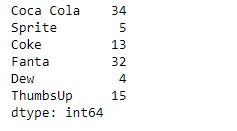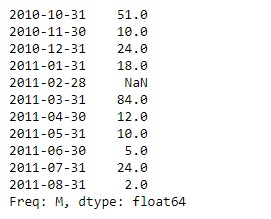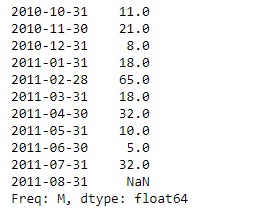Pandas 係列是帶有軸標簽的一維ndarray。標簽不必是唯一的,但必須是可哈希的類型。該對象同時支持基於整數和基於標簽的索引,並提供了許多方法來執行涉及索引的操作。
Pandas Series.corr()函數計算與其他係列的相關性,排除缺失值。
用法: Series.corr(other, method=’pearson’, min_periods=None)
參數:
other:係列
method:{'pearson','kendall','spearman'}或可致電
min_periods:獲得有效結果所需的最少觀察數
返回:相關性:浮點數
範例1:采用Series.corr()函數查找給定係列對象與另一個對象的相關性。
# importing pandas as pd
import pandas as pd
# Creating the first Series
sr1 = pd.Series([80, 25, 3, 25, 24, 6])
# Creating the second Series
sr2 = pd.Series([34, 5, 13, 32, 4, 15])
# Create the Index
index_ = ['Coca Cola', 'Sprite', 'Coke', 'Fanta', 'Dew', 'ThumbsUp']
# set the first index
sr1.index = index_
# set the second index
sr2.index = index_
# Print the first series
print(sr1)
# Print the second series
print(sr2)輸出:


現在我們將使用Series.corr()函數查找給定係列對象的基礎數據與其他對象之間的相關性。
# find the correlation
result = sr1.corr(sr2)
# Print the result
print(result)輸出:

正如我們在輸出中看到的,Series.corr()函數已成功返回給定係列對象的基礎數據之間的相關性。
範例2:采用Series.corr()函數查找給定係列對象與另一個對象的相關性。係列對象包含一些缺失值。
# importing pandas as pd
import pandas as pd
# Creating the first Series
sr1 = pd.Series([51, 10, 24, 18, None, 84, 12, 10, 5, 24, 2])
# Creating the second Series
sr2 = pd.Series([11, 21, 8, 18, 65, 18, 32, 10, 5, 32, None])
# Create the Index
index_ = pd.date_range('2010-10-09', periods = 11, freq ='M')
# set the first index
sr1.index = index_
# set the second index
sr2.index = index_
# Print the first series
print(sr1)
# Print the second series
print(sr2)輸出:


現在我們將使用Series.corr()函數查找給定係列對象的基礎數據與其他對象之間的相關性。
# find the correlation
result = sr1.corr(sr2)
# Print the result
print(result)輸出:

正如我們在輸出中看到的,Series.corr()函數已成功返回給定係列對象的基礎數據之間的相關性。在計算對象之間的相關性時,將跳過缺少的值。
相關用法
- Python pandas.map()用法及代碼示例
- Python Pandas Series.str.len()用法及代碼示例
- Python Pandas.factorize()用法及代碼示例
- Python Pandas TimedeltaIndex.name用法及代碼示例
- Python Pandas dataframe.ne()用法及代碼示例
- Python Pandas Series.between()用法及代碼示例
- Python Pandas DataFrame.where()用法及代碼示例
- Python Pandas Series.add()用法及代碼示例
- Python Pandas.pivot_table()用法及代碼示例
- Python Pandas Series.mod()用法及代碼示例
- Python Pandas Dataframe.at[ ]用法及代碼示例
- Python Pandas Dataframe.iat[ ]用法及代碼示例
- Python Pandas.pivot()用法及代碼示例
- Python Pandas dataframe.mul()用法及代碼示例
- Python Pandas.melt()用法及代碼示例
注:本文由純淨天空篩選整理自Shubham__Ranjan大神的英文原創作品 Python | Pandas Series.corr()。非經特殊聲明,原始代碼版權歸原作者所有,本譯文未經允許或授權,請勿轉載或複製。
